Baking for Easter
The History of Hot Cross Buns
~ Traditional Hot Cross Buns Recipe ~
Hot Cross buns have quite a history behind them; the idea of marking crosses on baked goods such as bread, cakes and buns goes right back to pre-Medieval times and was a visible sign that the bread was “blessed” and had the power to ward off evil spirits, as well as help with the longevity of the bread by stopping it going mouldy or becoming stale so quickly. A cross marked on the dough was also believed to help the bread to rise. The first buns with crosses that were attributed to the festival of Easter came along a little later however, as Kate Colquhoun states in her excellent book “Taste: The Story Of Britain Through Its Cooking“……….“In honour of Eastre, goddess of spring and the dawn, [Anglo-Saxon] bread dough could be studded with dried fruits and baked into small loaves that, as Christianity spread, began to be marked with a cross by monks: the earliest form of hot-cross bun”. It can be said that these were the earliest examples of what we know to be Hot Cross Buns today, and from the late 1600’s onwards the custom grew that special spices buns known as “Good Friday Buns” were to be marked with a cross and were to be eaten for breakfast on Good Friday.
Although the name for Hot Cross Buns was commonly known as Good Friday Buns for nearly a hundred years, during the 1730’s the buns were starting to be sold on the streets, and therein the name as well as the popular rhyme emerged, as the sellers would shout out ” One-a-penny, two-a-penny, hot-cross buns “………..a penny for a larger bun or for two smaller ones. This tradition was still in practice as little as eighty years ago, as my dad can remember the Hot Cross Bun sellers coming around the streets to sell them on Good Friday. Nowadays, you can buy Hot Cross Buns all year around, which I think is a great shame, as it cheapens and weakens the history and traditions behind this wonderful spiced bun.
It is to be noted that prior to our Hot Cross Buns being an edible symbol of Christianity, there were similar small cakes made for the Anglo-Saxon goddess Eostre, and as part of the pagan celebration of spring. And, it is well documented that the Greeks and Romans also had festive spring cakes which bore some similarity to our own Hot Cross Buns. The original reasons for the marking of crosses on baked goods, as well as the superstitions that grounds the practice, is recorded in the popular rhyme below:
“Good Friday comes this month—the old woman runs
With one or two a-penny hot cross buns,
Whose virtue is, if you believe what’s said,
They’ll not grow mouldy like the common bread.”
One of the most well-known traditions surrounding Hot Cross Buns is still in practice today and takes place in a London Pub! At the Pub, The Widow’s Son at Bromley by Bow, a Hot Cross Bun Ceremony takes place each Good Friday. In the early 19th century, a widow who lived on the site was expecting her sailor son back home for Easter, and placed a hot cross bun ready for him on Good Friday. The son never returned, but undaunted the widow left the bun waiting for him and added a new bun each year. Successive landlords have kept the tradition going after the pub was opened. You can still have a pint in the pub if you wish today, whilst admiring the collection of Hot Cross Buns in various stages of decay! As you can see from the photo below, there is a net of Hot Cross Buns that hangs above the bar at The Widow’s Son, and each year a sailor comes to add another bun to the collection, the buns being baked specially for the occasion with the current year piped on them between the cross.
But back to my recipe for Hot Cross Buns; this recipe is adapted from a Tudor recipe for spiced baked buns, and has been my favourite Hot Cross Bun recipe for some years now, mainly for the blend of spices and fruity filling, as well as a light but filling nice texture too. I add an egg to my flour paste for the crosses, hence them being so yellow – NO artificial colouring there, but just good free-range eggy goodness! However, if you prefer a cross in a lighter hue of yellow, just rub some butter into some flour and add some milk or eater until you have a stiff paste that can be piped onto the buns. I made two dozen of these yesterday in readiness for Easter as they freeze so well; just remember to take them out to defrost, although they will defrost quite nicely in a cool to warm oven and of course, some modern toasters have a “defrost” setting on them too. I hope you have enjoyed recipe number two in my Easter collection, I will be back tomorrow as usual with a rather nice egg recipe! Have a great day, Karen.
Hot Cross Buns
| Serves | 12 Hot Cross Buns |
| Prep time | 2 hours |
| Cook time | 20 minutes |
| Total time | 2 hours, 20 minutes |
| Allergy | Egg, Milk, Wheat |
| Dietary | Vegetarian |
| Meal type | Bread, Breakfast, Dessert, Side Dish, Snack |
| Misc | Child Friendly, Freezable, Serve Cold, Serve Hot |
| Region | British |
| By author | Karen S Burns-Booth |
Ingredients
- 450g strong white bread flour
- 1/2 teaspoon salt
- 1 1/2 teaspoons mixed spice
- 1/2 teaspoon cinnamon
- 50g butter
- 50g caster sugar
- 1 1/2 teaspoon easy-blend dried yeast
- 210ml tepid milk
- 1 free-range egg
- 100g mixed dried fruit
- 25g cut mixed citrus peel
- 50g plain flour (for the crosses)
- 1 free-range egg (for the crosses)
- 30ml milk (for the glaze)
- 25g caster sugar (for the glaze)
Note
If you have a bread machine, you can start the dough in the machine up to the second proving stage. Add the dried fruit 5 minutes before the end of kneading or when your bread machine beeps.
Directions
| Step 1 | Sieve the flour, salt, ground mixed spice and cinnamon into a large mixing bowl, then rub in the butter using your fingertips. Make a well in the centre of the mixture, then add the sugar and yeast. |
| Step 2 | Beat the egg and add to the flour with the tepid milk. Mix together to a form a soft, pliable dough. Turn out the dough onto a lightly floured work surface. Carefully work the mixed dried fruit and mixed peel into the dough until well combined. Knead lightly for 5 minutes, or until smooth and elastic. |
| Step 3 | Shape the dough into a ball and place it into the buttered/greased mixing bowl, then cover with a clean tea towel and set aside in a warm place for one hour to prove. |
| Step 4 | Turn out the proved dough onto a lightly floured work surface and knock back the dough. Shape it into a ball again and return it to the bowl, then cover again with the tea towel and set aside for a further 30 minutes to rise. |
| Step 5 | Turn out the dough onto a lightly floured work surface and divide it into 12 equal pieces. Roll each piece into a ball, then flatten slightly into a bun shape using the palms of your hands. Cover the buns again with the tea towel and set aside to rest for 5-10 minutes. |
| Step 6 | Meanwhile, make the mixture for the crosses; mix the flour and egg to a stiff paste, but thin enough to pipe. Make the glaze too - heat the milk and sugar together until the sugar has dissolved and set aside. |
| Step 7 | Place the hot cross buns onto buttered/greased baking trays, then place the tray/s inside a large oiled polythene bag. Tie the end of the bag tightly so that no air can get in and set aside in a warm place for a further 40 minutes to rise. |
| Step 8 | Preheat the oven to 240C/475F/Gas 8. |
| Step 9 | When the buns have risen, remove them from inside the polythene bag, and then spoon the flour and egg mixture into a piping bag and pipe a cross on each bun. |
| Step 10 | Bake the buns in the pre-heated oven for 15 to 18 minutes, or until pale golden-brown, and when turned over and tapped on the underneath they sound hollow. As soon as you remove the buns from the oven, brush them with the sugar and milk syrup, then set aside to cool on a wire rack. |
| Step 11 | Serve warm, split and spread with butter, or serve toasted, split and spread with butter. The cooked buns can be frozen for up to 3 months; allow 6 hours for them to defrost and serve as above. |

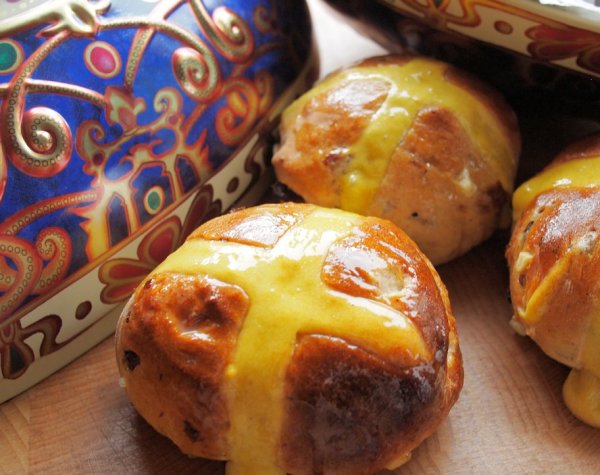
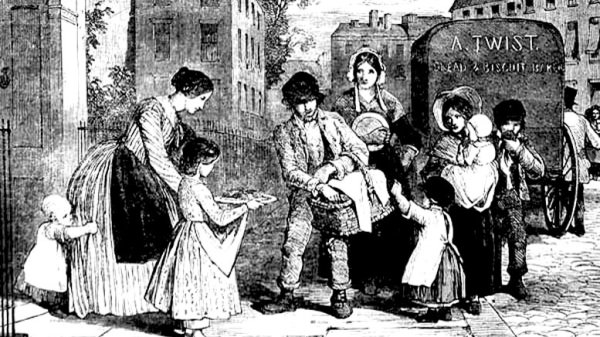
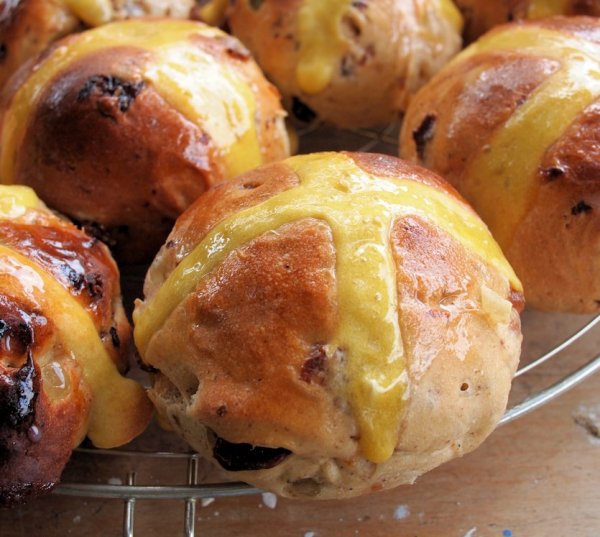
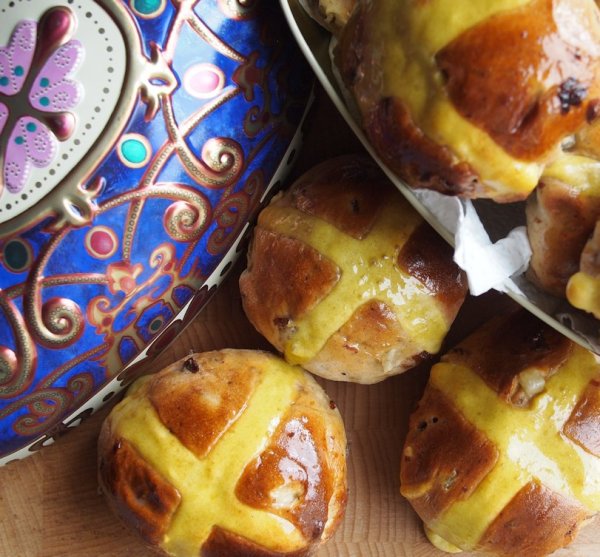
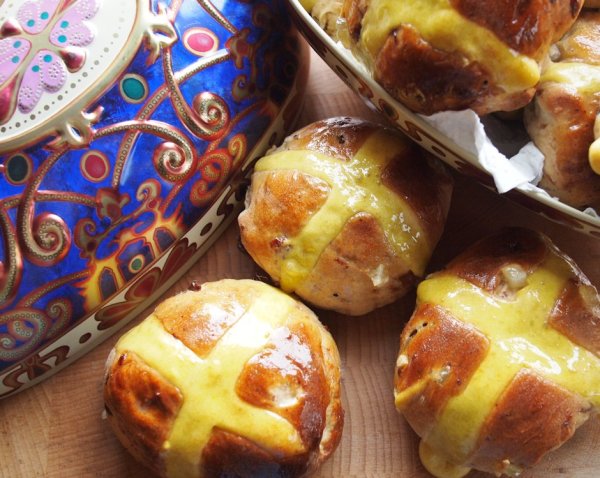

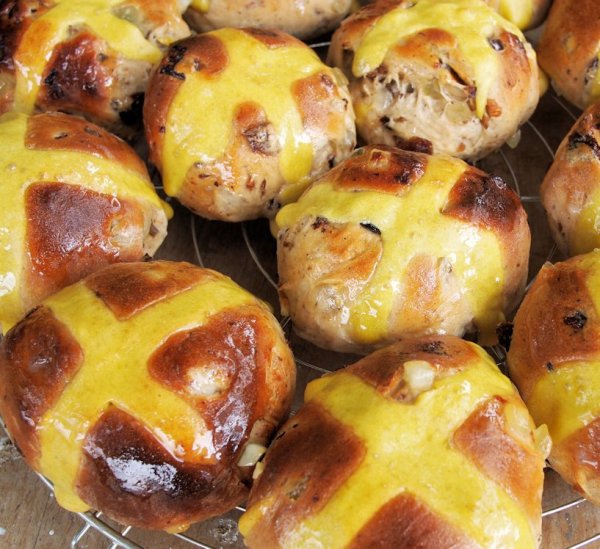
 Print recipe
Print recipe
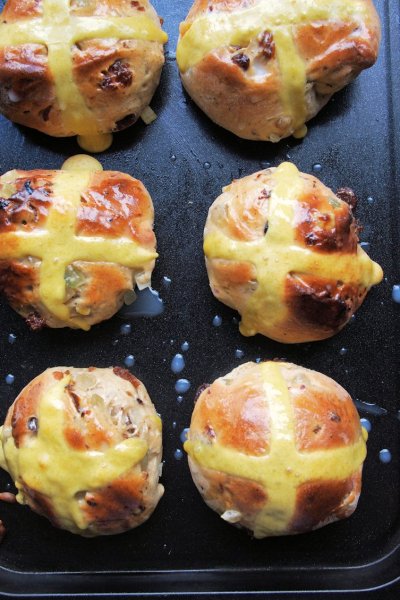


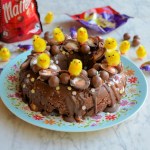


Bob Moss says
They look stunning! I’ve just printed off the recipe and might given them a go this afternoon!
Karen says
Brilliant! Thanks Bob and also for the DM too on Twitter! 🙂
A Trifle Rushed says
Thank you for a great recipe, I was hoping you would post one. I’ve never baked hot cross buns but seeing yours looking so tasty I’m going to try next week. (And if they are as successful as yours, I may even bake them again in France for the neighbours!) Thank you Karen. I love the marbled eggs too, I must paint some this year with C, we have the dunes nearby which will be ideal for egg rolling! Jude x
Karen says
Thanks Jude, there was an error in the recipe software earlier, all fixed now, so if you have printed the recipe already you will need to amend it! These are so delicious and I am pleased that they are all made for Easter now! Karen
rebecca says
fun post Karen love the history and they look perfect
Karen says
Thanks Rebecca! They tasted great too! 🙂
Dominic says
they look glorious… I love the fact that you’ve put egg into the crosses, something i don’t do but it really works doesn’t it?… lovely!
Karen says
Thanks Dom, I have always put an egg into my pasted for the crosses, it makes them yellow, naturally, and works, as you say!
Kate - Turquoise Lemons says
These look positively scrumptious and I am salivating thinking of the flavours. I may just try these over Easter. x
Karen says
Let me know if you try these Kate, if you make bread, they are no different apart from the crosses and sugar glaze, and worth the effort!
Janice says
I love how religion hijacks all the favourite pagan symbols and then forgets their origin, just as well we have you to remind us, Karen!
I was fascinated by your crosses as soon as I saw them, I’m never sure what to make them from there are so many options and some of them taste awful. I like the idea of using egg, seems appropriate for Easter!
Karen says
Thanks Janice, many of the so called “Christian” traditions are “borrowed” from ancient pagan rites…..the church adopted lots of them and then made them “holy”! As for my crosses, I have always used egg as part of the paste for the crosses, seems right for an Easter treat, as you say, and is better then making a “runny” pastry with flour, margarine and then water, IMHO!
Lauren says
You’ll be glad to know that Hot Cross Buns only show up around Easter here in Kansas. I was familiar with the nursery rhyme, but I’d never seen the buns for sale until we moved here almost four years ago. I must say that yours look ten times better than bakery Hot Cross Buns and I’ll have to try them out.
Karen says
That’s good to know Lauren, as in the UK you can just about buy Hot Cross Buns all year around, which I think is a shame! These really are SO much better than commercial buns, and if you have some baking time, they are quite easy to whip up, and if you batch bake as I did, they freeze well too.
Susan Otto says
They look absolutely amazing. I might just give these a try for Easter brunch. I love the your directions are posted, It makes it so easy to read and follow.
Karen says
Thanks Susan! I am glad that the directions will help you, I always try to set them out as I would want to see them when baking!
karin@yumandmore says
Lovely post Karen – so nice to read about the traditions – so reminds me of childhood and Mother Goose and Easter bonnets. Thank you!
Karen says
Thanks Karin, I think it is important to keep history alive as well as baking traditional Easter treats too!
heather says
These look amazing, Karen! I always love all the historical detail you give for your recipes. I might have to try this!
Karen says
Thanks Heather, I do love my culinary history! 🙂
Smells Like Salad says
I can attest to this recipe: it is fabulous!
Karen says
Thanks Mary! I remember you made these…..:-)
Nic says
You can’t beat a home-made hot cross bun, they look delicious! Must make some for Easter. Great post Karen.
Karen says
Thanks Nic, lovely to see you here, how are you?
Javelin Warrior says
These buns look fantastic, Karen – and I’m so glad you shared the story of origins. My mom made these for years and I vaguely remember hearing a similar story about how the buns came into existence – but like then, I’m still far to busy gazing at the buns to pay close attention 😉
Karen says
Thanks! These Hot Cross Buns mean Easter to me, always have done and I remember being excited when mum started to make them or buy them.
Jaime says
These look perfect – I can’t wait to try the recipe for the coming Good Friday! Thanks for sharing the history behind these delightful buns, Karen. Great post 🙂
Karen says
Thanks Jaime, do let me know if you make them and if there are any tips I can share!
laura@howtocookgoodfood says
I knew your hot cross buns would be fantastic! I have a bag of mixed dried fruit ready and waiting to give your recipe a go. I will be trying them once the Easter holidays are here….can’t wait 🙂
Karen says
Brilliant, thanks for your lovely comments Laura! DO let me know if you make them and how they turn out!
Celia Lindsell says
My god seeing those hot cross buns makes me want onw NOW! My monoflora Provencal Lavender Honey is just the best with hot cross buns. Happy Easter
Karen says
I bet these would be great with honey, hot and buttered with honey……:-)
What Kate Baked says
I absolutely love a Hot Cross Bun Karen and really enjoyed reading all the history and traditions behind the beautiful buns! I’ll have to seek out that London Pub- great post and tale!
Karen says
I am going to try to get to that pub if I can too, maybe we can meet there for a bun fight! LOL! 🙂
RelishPDX says
Hi,
Are you positive about the oven temp and baking time? I peeked at the 10-minute mark with the oven at 475°F (verified by oven thermometer), and I would have had Hot Charred Buns by the 11-minute mark. The centers were fully baked, so no harm done, but you should double-check the recipe. I can’t imagine what 18 minutes would have done to them.
Mighty tasty buns, though. Thanks for the recipe!
Karen says
Hi! The recipe states between 15 and 18 minutes and it really depends on the size of the buns and your oven, because they DO vary! I am 100% confident about the timings in this recipe as I have made them so many times, and they bake for me between 15 to 18 minutes…..glad they were tasty though!
Torie says
Such an informative blog post, I love hearing the history behind our beloved hot cross buns. Will save this ready for next year.
Karen says
Thanks Torie – I love food history and often research and write about it! Karen
Fiona Matters says
Easter is coming up again and I’m determined to make my own hot crossed buns! The history is absolutely fascinating too.
mandy waller says
Shared this as it looks amazing 🙂
Camilla says
You’re very good Karen, the last time I made these was at school and they probably weren’t great! Yours look stupendous – well done:-)
Karen Booth says
Thanks Camilla! I am just about to post a new version, made in a muffin tin! Karen
Regula @ Miss Foodwise says
Love this post! I had to do a piece about Hot Cross Buns for a magazine back in januari, wish I had known you knew so much about them! They look great!
Heather says
Hi, Karen! I didn’t use your recipe exactly but I did make my crosses with the flour/egg paste and brushed them with the syrup. Turned out great! I love that the crosses were baked into the bun instead of just being icing piped on afterward. Thanks for the tip!
Also, I agree that I would have had hockey pucks had I baked them at 475. I did 375 for 18 minutes and they came out perfect.
d3bug says
“Mixed Spice”….. ummmm…. which spices precisely and in what quantities? There are literally thousands of available spices in the world today.
Karen Burns-Booth says
Mixed spice is a British term for a sweet pudding spice – it’s sold as mixed spice. The US equivalent is Pumpkin Pie Spice I believe. I realise there are thousands of spice mixtures in the world today, but most avid cooks will know of British Mixed Spice!